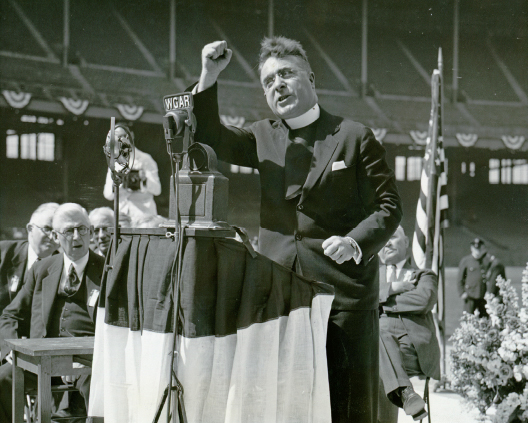Exploring American Histories: Printed Page 699
Exploring American Histories, Value Edition: Printed Page 579
New Deal Critics
Despite the unprecedented efforts of the Roosevelt administration to spark recovery, provide relief, and encourage reform between 1933 and 1935, the country remained in depression, and unemployment still hovered around 20 percent. A liberal but not a radical, Roosevelt found himself under attack from both the left and the right. On the right, conservatives questioned New Deal spending and the growth of big government. On the left, the president’s critics argued that he had not done enough to topple wealthy corporate leaders from power and relieve the plight of the downtrodden. (See e-Document Project 22: Franklin Roosevelt’s New Deal and Its Critics.)
The Great Depression and Hoover’s inability to ameliorate its most damaging effects dealt a serious blow to the Republican Party and to the conservative opposition to federal government intervention with which it was identified. In 1934 officials of the Du Pont Corporation and General Motors formed the American Liberty League. The group, according to one of its founders, set out to educate the nation about “the value of encouraging people to work; encouraging people to get rich.” From the point of view of the league’s founders, the New Deal was little more than a vehicle for the spread of socialism and communism. The organization spent $1 million attacking what it considered to be Roosevelt’s “dictatorial” policies and his assaults on free enterprise. The league, however, failed to attract support beyond a small group of northern industrialists, Wall Street bankers, and a few disaffected Democrats.
Roosevelt also faced criticism from the left. Communist Party membership reached its peak of around 75,000 in 1938, and though the party remained relatively small in numbers, it attracted intellectuals and artists whose voices could reach the larger public. The party’s efforts to save the Scottsboro Nine boosted its appeal among African Americans. Party members also led unionizing drives in both the North and the South and displayed great talent and energy in organizing workers where resistance to unions was greatest. In the mid-1930s, the party followed the Soviet Union’s antifascist foreign policy and joined with left-leaning, non-Communist groups, such as unions and civil rights organizations, to oppose the growing menace of fascism in Europe, particularly in Germany and Italy. By the end of the decade, however, the party had lost many members, as revelations about the tyrannical behavior of the Soviet dictator Joseph Stalin emerged and after the Soviet Union reversed its anti-Nazi foreign policy.
The greatest challenge to Roosevelt came from a trio of talented men who reflected diverse beliefs. Through charisma, organizational skills, or a combination of both, each of them created his own national campaign criticizing the New Deal. Francis Townsend, a retired California physician, proposed a “Cure for Depressions.” In 1934 he formed the Old-Age Revolving Pensions Corporation, whose title summed up the doctor’s idea. Townsend would have the government give all Americans over the age of sixty a monthly pension of $200 if they retired and spent the entire stipend each month. He promoted this scheme as a simple panacea for the ailing economy. Retirements would open up jobs for younger workers, and the income these workers received, along with the pension for the elderly, would pump ample funds into the economy to promote recovery. The government would fund the Townsend plan with a 2 percent “transaction” or sales tax. By 1936 Townsend Clubs had attracted about 3.5 million members throughout the country, and one-fifth of all adults in the United States signed a petition endorsing the Townsend plan.
While Townsend appealed mainly to the elderly, Charles E. Coughlin attracted Catholics and a lower-middle-class following. An outspoken priest from the Detroit suburb of Royal Oak, Michigan, Father Coughlin used his popular national radio broadcasts to talk about economic and political issues. Originally a Roosevelt supporter, by 1934 Coughlin had begun criticizing the New Deal for catering to greedy bankers. He spoke to millions of radio listeners about the evils of the Roosevelt administration, the godless Communists who had allegedly infested it, and international bankers—coded language referring to Jews—who supposedly manipulated it. In 1935 Coughlin’s popularity reached its peak as he organized the National Union for Social Justice, which supported monetary inflation to help debt-ridden farmers and the nationalization of banks to control lending practices. As the decade wore on, his strident anti-Semitism and his growing fondness for fascist dictatorships abroad overshadowed his economic justice message, and Catholic officials ordered him to stop broadcasting.

Huey Pierce Long of Louisiana, known as “the Kingfish,” posed the greatest political threat to Roosevelt. Unlike Townsend and Coughlin, Long had built and operated a successful political machine, first as governor and then as U.S. senator, taking on the special interests of oil and railroad corporations in his home state. Early on he had backed Roosevelt, but Long found the New Deal wanting. “Not a single thin dime of concentrated, bloated, pompous wealth, massed in the hands of a few people,” Long claimed, “has been raked down to relieve the masses.” In 1934 Long established the Share Our Wealth society, promising to make “every man a king” by presenting families with a $5,000 homestead and a guaranteed annual income of $2,000. To accomplish this, Long proposed levying heavy income and inheritance taxes on the wealthy. Although the financial calculations behind his bold plan did not add up, Share Our Wealth clubs counted some seven million members. The swaggering senator departed from most of his segregationist southern colleagues by appealing to a coalition of disgruntled farmers, industrial workers, and African Americans (as governor of Louisiana, he supported repeal of the poll tax). Before Long could help lead a third-party campaign for president, he was shot and killed in 1935.
Review & Relate
|
What steps did Roosevelt take to stimulate economic recovery and provide relief to impoverished Americans during his first term in office? |
What criticisms did Roosevelt’s opponents level against the New Deal? |